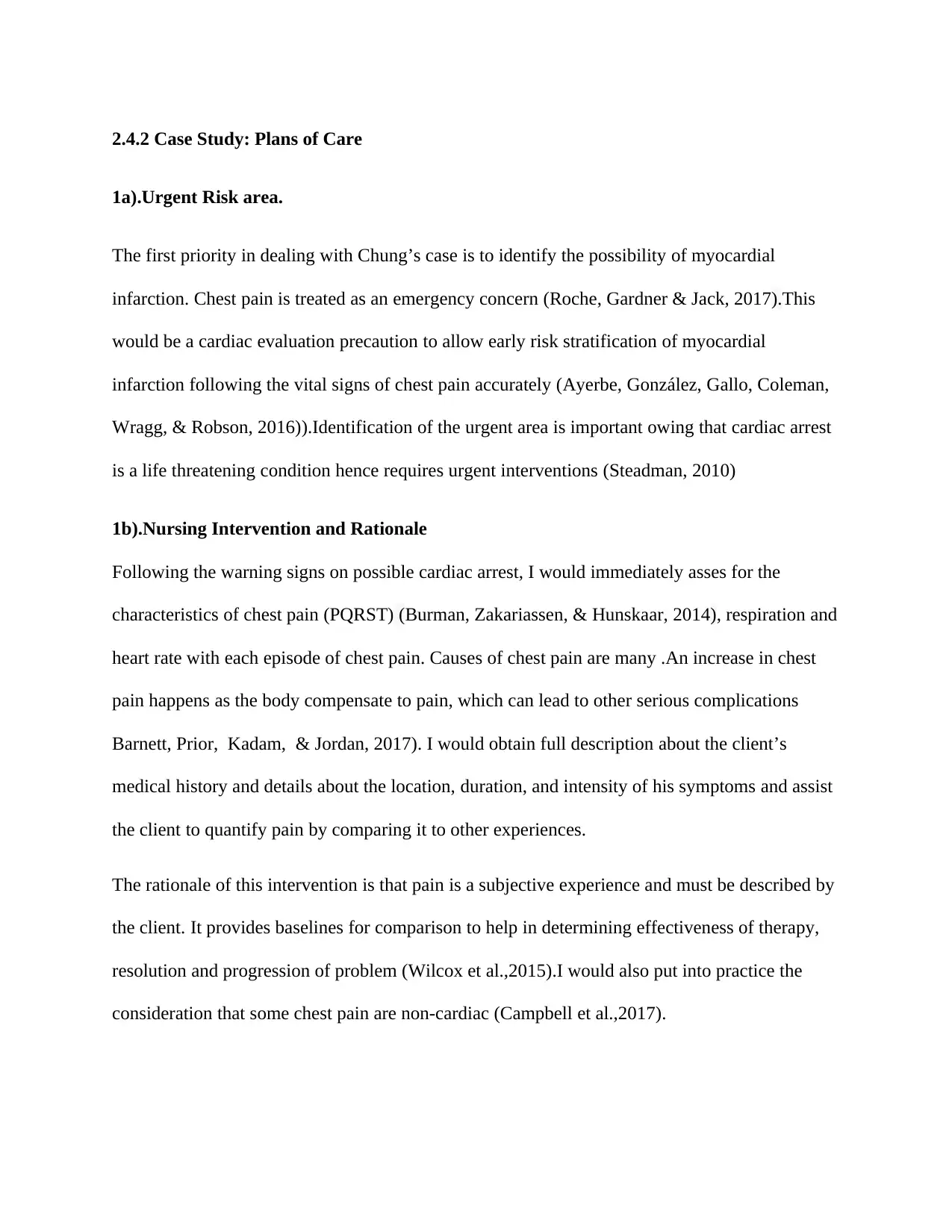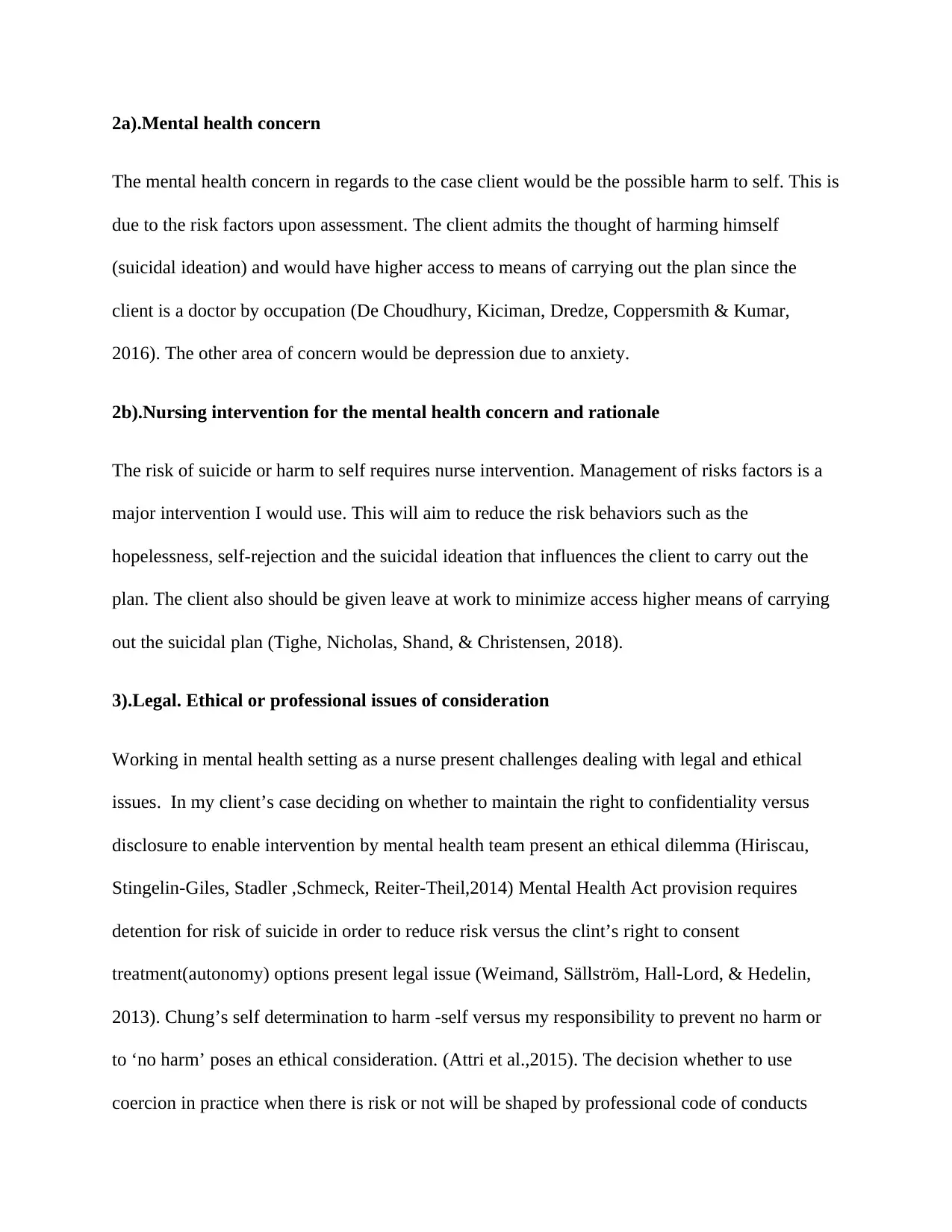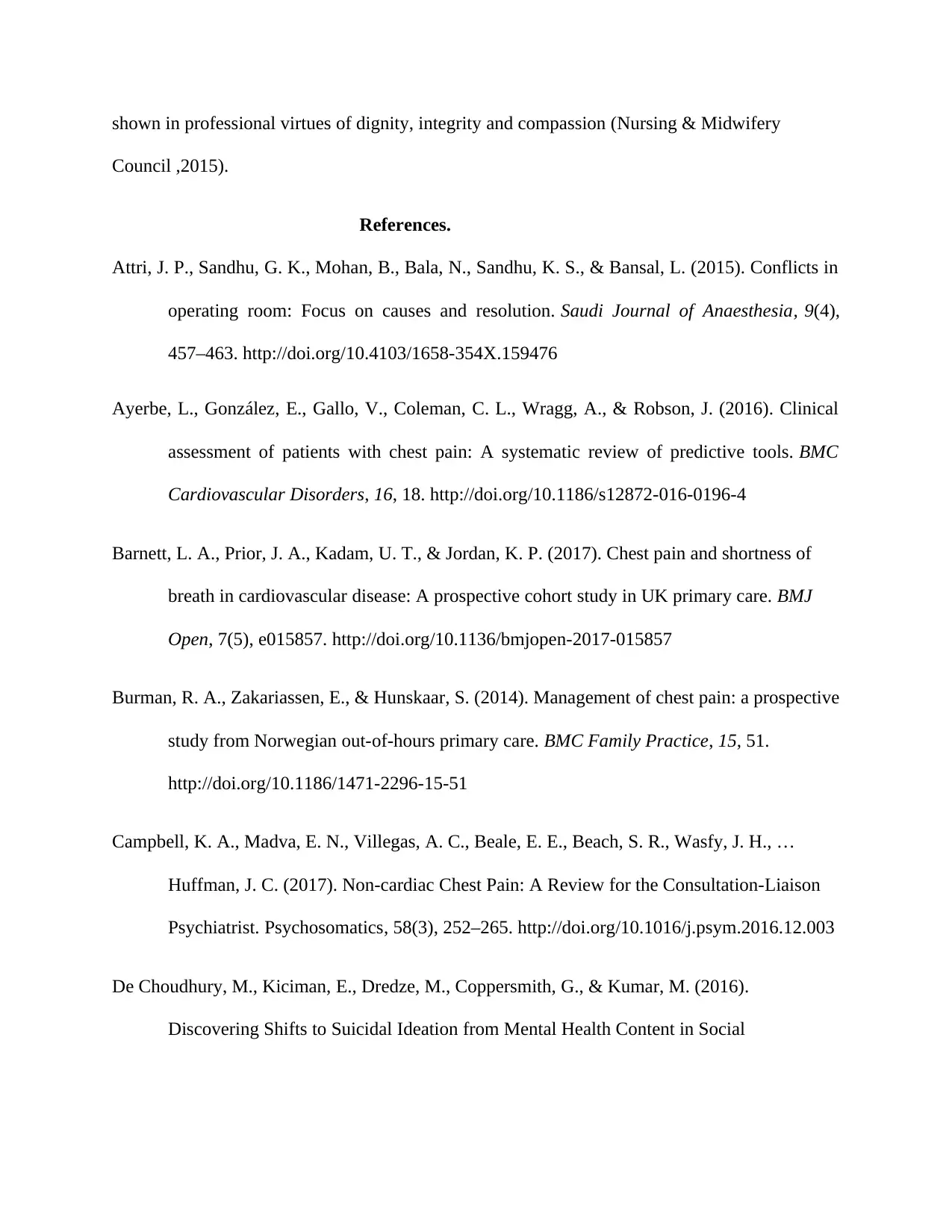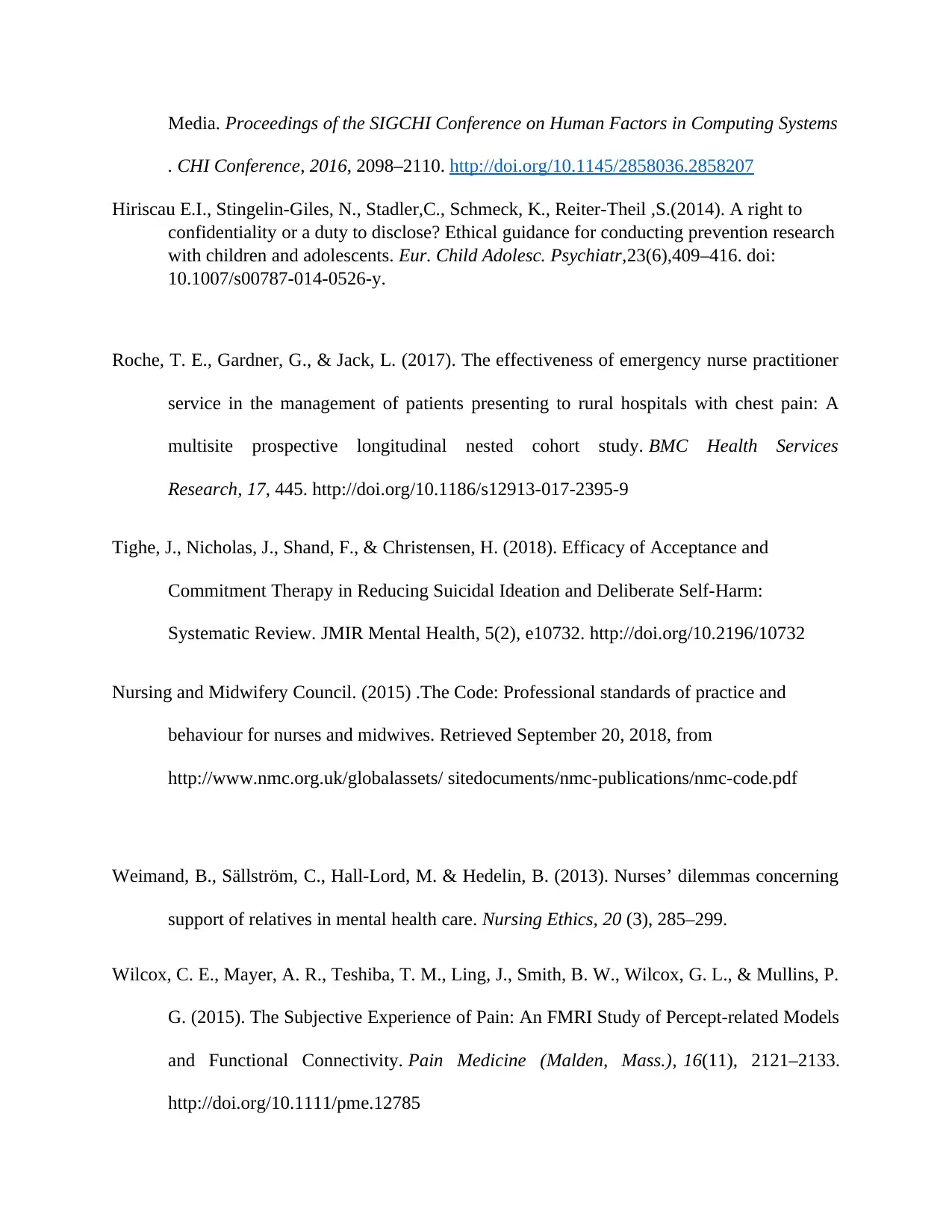401013 Case Study: Promoting Mental Health and Wellbeing 1
VerifiedAdded on 2023/06/09
|4
|1321
|307
Case Study
AI Summary
This case study analyzes a nursing scenario involving a patient, Chung, presenting with chest pain and suicidal ideation, highlighting the need for urgent care and risk management. The assignment prioritizes identifying potential myocardial infarction and addressing the patient's mental health concerns, including suicidal thoughts and depression. It details nursing interventions, such as assessing chest pain characteristics (PQRST), obtaining the patient's medical history, and providing leave from work to minimize access to means of self-harm. The study also explores ethical and legal considerations, such as maintaining confidentiality versus disclosure, the right to consent, and the nurse's responsibility to prevent harm. The case study emphasizes the importance of professional conduct, including dignity, integrity, and compassion, in making decisions about coercion and treatment. References from recent literature are provided to support the analysis of the case.

2.4.2 Case Study: Plans of Care
1a).Urgent Risk area.
The first priority in dealing with Chung’s case is to identify the possibility of myocardial
infarction. Chest pain is treated as an emergency concern (Roche, Gardner & Jack, 2017).This
would be a cardiac evaluation precaution to allow early risk stratification of myocardial
infarction following the vital signs of chest pain accurately (Ayerbe, González, Gallo, Coleman,
Wragg, & Robson, 2016)).Identification of the urgent area is important owing that cardiac arrest
is a life threatening condition hence requires urgent interventions (Steadman, 2010)
1b).Nursing Intervention and Rationale
Following the warning signs on possible cardiac arrest, I would immediately asses for the
characteristics of chest pain (PQRST) (Burman, Zakariassen, & Hunskaar, 2014), respiration and
heart rate with each episode of chest pain. Causes of chest pain are many .An increase in chest
pain happens as the body compensate to pain, which can lead to other serious complications
Barnett, Prior, Kadam, & Jordan, 2017). I would obtain full description about the client’s
medical history and details about the location, duration, and intensity of his symptoms and assist
the client to quantify pain by comparing it to other experiences.
The rationale of this intervention is that pain is a subjective experience and must be described by
the client. It provides baselines for comparison to help in determining effectiveness of therapy,
resolution and progression of problem (Wilcox et al.,2015).I would also put into practice the
consideration that some chest pain are non-cardiac (Campbell et al.,2017).
1a).Urgent Risk area.
The first priority in dealing with Chung’s case is to identify the possibility of myocardial
infarction. Chest pain is treated as an emergency concern (Roche, Gardner & Jack, 2017).This
would be a cardiac evaluation precaution to allow early risk stratification of myocardial
infarction following the vital signs of chest pain accurately (Ayerbe, González, Gallo, Coleman,
Wragg, & Robson, 2016)).Identification of the urgent area is important owing that cardiac arrest
is a life threatening condition hence requires urgent interventions (Steadman, 2010)
1b).Nursing Intervention and Rationale
Following the warning signs on possible cardiac arrest, I would immediately asses for the
characteristics of chest pain (PQRST) (Burman, Zakariassen, & Hunskaar, 2014), respiration and
heart rate with each episode of chest pain. Causes of chest pain are many .An increase in chest
pain happens as the body compensate to pain, which can lead to other serious complications
Barnett, Prior, Kadam, & Jordan, 2017). I would obtain full description about the client’s
medical history and details about the location, duration, and intensity of his symptoms and assist
the client to quantify pain by comparing it to other experiences.
The rationale of this intervention is that pain is a subjective experience and must be described by
the client. It provides baselines for comparison to help in determining effectiveness of therapy,
resolution and progression of problem (Wilcox et al.,2015).I would also put into practice the
consideration that some chest pain are non-cardiac (Campbell et al.,2017).
Paraphrase This Document
Need a fresh take? Get an instant paraphrase of this document with our AI Paraphraser

2a).Mental health concern
The mental health concern in regards to the case client would be the possible harm to self. This is
due to the risk factors upon assessment. The client admits the thought of harming himself
(suicidal ideation) and would have higher access to means of carrying out the plan since the
client is a doctor by occupation (De Choudhury, Kiciman, Dredze, Coppersmith & Kumar,
2016). The other area of concern would be depression due to anxiety.
2b).Nursing intervention for the mental health concern and rationale
The risk of suicide or harm to self requires nurse intervention. Management of risks factors is a
major intervention I would use. This will aim to reduce the risk behaviors such as the
hopelessness, self-rejection and the suicidal ideation that influences the client to carry out the
plan. The client also should be given leave at work to minimize access higher means of carrying
out the suicidal plan (Tighe, Nicholas, Shand, & Christensen, 2018).
3).Legal. Ethical or professional issues of consideration
Working in mental health setting as a nurse present challenges dealing with legal and ethical
issues. In my client’s case deciding on whether to maintain the right to confidentiality versus
disclosure to enable intervention by mental health team present an ethical dilemma (Hiriscau,
Stingelin-Giles, Stadler ,Schmeck, Reiter-Theil,2014) Mental Health Act provision requires
detention for risk of suicide in order to reduce risk versus the clint’s right to consent
treatment(autonomy) options present legal issue (Weimand, Sällström, Hall-Lord, & Hedelin,
2013). Chung’s self determination to harm -self versus my responsibility to prevent no harm or
to ‘no harm’ poses an ethical consideration. (Attri et al.,2015). The decision whether to use
coercion in practice when there is risk or not will be shaped by professional code of conducts
The mental health concern in regards to the case client would be the possible harm to self. This is
due to the risk factors upon assessment. The client admits the thought of harming himself
(suicidal ideation) and would have higher access to means of carrying out the plan since the
client is a doctor by occupation (De Choudhury, Kiciman, Dredze, Coppersmith & Kumar,
2016). The other area of concern would be depression due to anxiety.
2b).Nursing intervention for the mental health concern and rationale
The risk of suicide or harm to self requires nurse intervention. Management of risks factors is a
major intervention I would use. This will aim to reduce the risk behaviors such as the
hopelessness, self-rejection and the suicidal ideation that influences the client to carry out the
plan. The client also should be given leave at work to minimize access higher means of carrying
out the suicidal plan (Tighe, Nicholas, Shand, & Christensen, 2018).
3).Legal. Ethical or professional issues of consideration
Working in mental health setting as a nurse present challenges dealing with legal and ethical
issues. In my client’s case deciding on whether to maintain the right to confidentiality versus
disclosure to enable intervention by mental health team present an ethical dilemma (Hiriscau,
Stingelin-Giles, Stadler ,Schmeck, Reiter-Theil,2014) Mental Health Act provision requires
detention for risk of suicide in order to reduce risk versus the clint’s right to consent
treatment(autonomy) options present legal issue (Weimand, Sällström, Hall-Lord, & Hedelin,
2013). Chung’s self determination to harm -self versus my responsibility to prevent no harm or
to ‘no harm’ poses an ethical consideration. (Attri et al.,2015). The decision whether to use
coercion in practice when there is risk or not will be shaped by professional code of conducts

shown in professional virtues of dignity, integrity and compassion (Nursing & Midwifery
Council ,2015).
References.
Attri, J. P., Sandhu, G. K., Mohan, B., Bala, N., Sandhu, K. S., & Bansal, L. (2015). Conflicts in
operating room: Focus on causes and resolution. Saudi Journal of Anaesthesia, 9(4),
457–463. http://doi.org/10.4103/1658-354X.159476
Ayerbe, L., González, E., Gallo, V., Coleman, C. L., Wragg, A., & Robson, J. (2016). Clinical
assessment of patients with chest pain: A systematic review of predictive tools. BMC
Cardiovascular Disorders, 16, 18. http://doi.org/10.1186/s12872-016-0196-4
Barnett, L. A., Prior, J. A., Kadam, U. T., & Jordan, K. P. (2017). Chest pain and shortness of
breath in cardiovascular disease: A prospective cohort study in UK primary care. BMJ
Open, 7(5), e015857. http://doi.org/10.1136/bmjopen-2017-015857
Burman, R. A., Zakariassen, E., & Hunskaar, S. (2014). Management of chest pain: a prospective
study from Norwegian out-of-hours primary care. BMC Family Practice, 15, 51.
http://doi.org/10.1186/1471-2296-15-51
Campbell, K. A., Madva, E. N., Villegas, A. C., Beale, E. E., Beach, S. R., Wasfy, J. H., …
Huffman, J. C. (2017). Non-cardiac Chest Pain: A Review for the Consultation-Liaison
Psychiatrist. Psychosomatics, 58(3), 252–265. http://doi.org/10.1016/j.psym.2016.12.003
De Choudhury, M., Kiciman, E., Dredze, M., Coppersmith, G., & Kumar, M. (2016).
Discovering Shifts to Suicidal Ideation from Mental Health Content in Social
Council ,2015).
References.
Attri, J. P., Sandhu, G. K., Mohan, B., Bala, N., Sandhu, K. S., & Bansal, L. (2015). Conflicts in
operating room: Focus on causes and resolution. Saudi Journal of Anaesthesia, 9(4),
457–463. http://doi.org/10.4103/1658-354X.159476
Ayerbe, L., González, E., Gallo, V., Coleman, C. L., Wragg, A., & Robson, J. (2016). Clinical
assessment of patients with chest pain: A systematic review of predictive tools. BMC
Cardiovascular Disorders, 16, 18. http://doi.org/10.1186/s12872-016-0196-4
Barnett, L. A., Prior, J. A., Kadam, U. T., & Jordan, K. P. (2017). Chest pain and shortness of
breath in cardiovascular disease: A prospective cohort study in UK primary care. BMJ
Open, 7(5), e015857. http://doi.org/10.1136/bmjopen-2017-015857
Burman, R. A., Zakariassen, E., & Hunskaar, S. (2014). Management of chest pain: a prospective
study from Norwegian out-of-hours primary care. BMC Family Practice, 15, 51.
http://doi.org/10.1186/1471-2296-15-51
Campbell, K. A., Madva, E. N., Villegas, A. C., Beale, E. E., Beach, S. R., Wasfy, J. H., …
Huffman, J. C. (2017). Non-cardiac Chest Pain: A Review for the Consultation-Liaison
Psychiatrist. Psychosomatics, 58(3), 252–265. http://doi.org/10.1016/j.psym.2016.12.003
De Choudhury, M., Kiciman, E., Dredze, M., Coppersmith, G., & Kumar, M. (2016).
Discovering Shifts to Suicidal Ideation from Mental Health Content in Social
⊘ This is a preview!⊘
Do you want full access?
Subscribe today to unlock all pages.

Trusted by 1+ million students worldwide

Media. Proceedings of the SIGCHI Conference on Human Factors in Computing Systems
. CHI Conference, 2016, 2098–2110. http://doi.org/10.1145/2858036.2858207
Hiriscau E.I., Stingelin-Giles, N., Stadler,C., Schmeck, K., Reiter-Theil ,S.(2014). A right to
confidentiality or a duty to disclose? Ethical guidance for conducting prevention research
with children and adolescents. Eur. Child Adolesc. Psychiatr,23(6),409–416. doi:
10.1007/s00787-014-0526-y.
Roche, T. E., Gardner, G., & Jack, L. (2017). The effectiveness of emergency nurse practitioner
service in the management of patients presenting to rural hospitals with chest pain: A
multisite prospective longitudinal nested cohort study. BMC Health Services
Research, 17, 445. http://doi.org/10.1186/s12913-017-2395-9
Tighe, J., Nicholas, J., Shand, F., & Christensen, H. (2018). Efficacy of Acceptance and
Commitment Therapy in Reducing Suicidal Ideation and Deliberate Self-Harm:
Systematic Review. JMIR Mental Health, 5(2), e10732. http://doi.org/10.2196/10732
Nursing and Midwifery Council. (2015) .The Code: Professional standards of practice and
behaviour for nurses and midwives. Retrieved September 20, 2018, from
http://www.nmc.org.uk/globalassets/ sitedocuments/nmc-publications/nmc-code.pdf
Weimand, B., Sällström, C., Hall-Lord, M. & Hedelin, B. (2013). Nurses’ dilemmas concerning
support of relatives in mental health care. Nursing Ethics, 20 (3), 285–299.
Wilcox, C. E., Mayer, A. R., Teshiba, T. M., Ling, J., Smith, B. W., Wilcox, G. L., & Mullins, P.
G. (2015). The Subjective Experience of Pain: An FMRI Study of Percept-related Models
and Functional Connectivity. Pain Medicine (Malden, Mass.), 16(11), 2121–2133.
http://doi.org/10.1111/pme.12785
. CHI Conference, 2016, 2098–2110. http://doi.org/10.1145/2858036.2858207
Hiriscau E.I., Stingelin-Giles, N., Stadler,C., Schmeck, K., Reiter-Theil ,S.(2014). A right to
confidentiality or a duty to disclose? Ethical guidance for conducting prevention research
with children and adolescents. Eur. Child Adolesc. Psychiatr,23(6),409–416. doi:
10.1007/s00787-014-0526-y.
Roche, T. E., Gardner, G., & Jack, L. (2017). The effectiveness of emergency nurse practitioner
service in the management of patients presenting to rural hospitals with chest pain: A
multisite prospective longitudinal nested cohort study. BMC Health Services
Research, 17, 445. http://doi.org/10.1186/s12913-017-2395-9
Tighe, J., Nicholas, J., Shand, F., & Christensen, H. (2018). Efficacy of Acceptance and
Commitment Therapy in Reducing Suicidal Ideation and Deliberate Self-Harm:
Systematic Review. JMIR Mental Health, 5(2), e10732. http://doi.org/10.2196/10732
Nursing and Midwifery Council. (2015) .The Code: Professional standards of practice and
behaviour for nurses and midwives. Retrieved September 20, 2018, from
http://www.nmc.org.uk/globalassets/ sitedocuments/nmc-publications/nmc-code.pdf
Weimand, B., Sällström, C., Hall-Lord, M. & Hedelin, B. (2013). Nurses’ dilemmas concerning
support of relatives in mental health care. Nursing Ethics, 20 (3), 285–299.
Wilcox, C. E., Mayer, A. R., Teshiba, T. M., Ling, J., Smith, B. W., Wilcox, G. L., & Mullins, P.
G. (2015). The Subjective Experience of Pain: An FMRI Study of Percept-related Models
and Functional Connectivity. Pain Medicine (Malden, Mass.), 16(11), 2121–2133.
http://doi.org/10.1111/pme.12785
1 out of 4
Related Documents
Your All-in-One AI-Powered Toolkit for Academic Success.
+13062052269
info@desklib.com
Available 24*7 on WhatsApp / Email
![[object Object]](/_next/static/media/star-bottom.7253800d.svg)
Unlock your academic potential
Copyright © 2020–2025 A2Z Services. All Rights Reserved. Developed and managed by ZUCOL.



